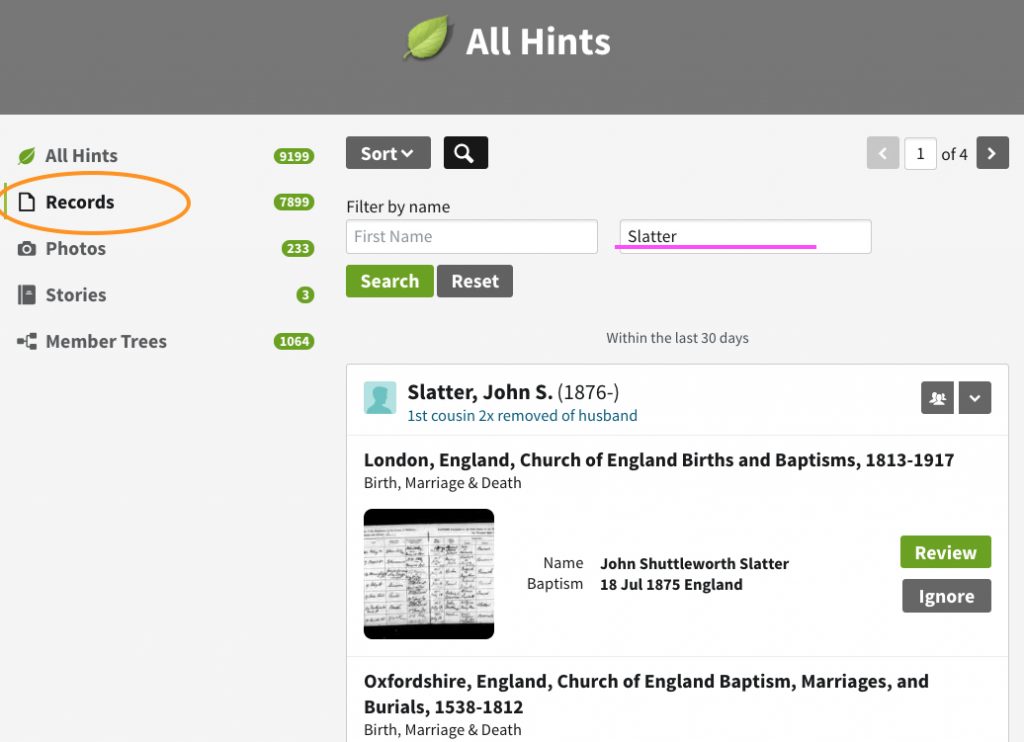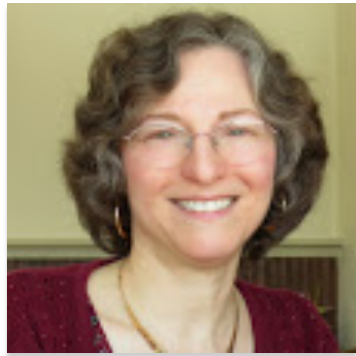Faced with over 9,000 “shaky leaf” hints for one Ancestry.com tree, Marian Wood (Climbing My Family Tree, author of the best-selling genealogy book, “Planning a Future for Your Family’s Past“) has to prioritize to make the most of her research time. In today’s “How I Solved It” guest blog post, Marian shares a shortcut to filter those hints and demonstrates why it’s never safe to assume a transcription is accurate, let alone complete.
_______________________________________________
Today, when I was clicking my merry way through online records pertaining to my husband’s Slatter family, I discovered one shortcut and was reminded, yet again, of the value of checking originals.
Above, the shortcut I found to cut through the clutter of hints. My husband’s Slatter family tree on Ancestry has more than 9,000 outstanding hints. Most of those are for ancestors too distant to be a priority. So I clicked on “records” to choose only those hints, then brought up the “filter by name” sorting option. (The default is “most recent” which means when Ancestry added that hint.)
By entering “Slatter” in the surname search box, I was able to view only record hints containing that name. Of course, I could have searched by first and last names, but given the creative spelling in so many records, I wanted to click through all Slatter record hints individually. Focusing on one surname enabled me to make progress, rather than being sidetracked by hints unrelated to my current research.

Now for the reminder about original records vs. transcriptions. The three dates on this record of marriage banns from a London church are 1 Dec, 8 Dec, and 15 Dec. The handwriting is very clear. At top of the page, not shown here, is the handwritten year–1907. Yet the transcription of this record says the year is 1908.
By reading the handwritten record, I was able to enter the correct dates for the marriage banns of Thomas Albert Slatter and Jessie Alice Elms. Also, the marriage license original confirmed the actual wedding day as 28 December 1907.
It’s never safe to assume a transcription is accurate, let alone complete. It took only a few more clicks to view the originals and extract every possible data point.
My starting point for today’s post was Elizabeth O’Neal’s Genealogy Blog Party, July edition: Virtual Research Trippin’.
*******************************************************
You can read Marian’s original post, with comments, at https://climbingmyfamilytree.blogspot.com/2018/07/lessons-learned-in-my-virtual-research.html
If you have ideas or stories to share in our “How I Solved It” series, please let us know!




Thank you for your post. I really enjoyed reading it, especially because it addressed my issue. http://www.kayswell.com It helped me a lot and I hope it will also help others.
Your articles are extremely helpful to me. Please provide more information! http://www.kayswell.com
I’m so in love with this. You did a great job!! http://www.hairstylesvip.com
Thank you for writing this post. I like the subject too. http://www.ifashionstyles.com
Thank you for your articles. I find them very helpful. Could you help me with something? http://www.kayswell.com
How can I find out more about it? http://www.hairstylesvip.com
Thanks for posting. I really enjoyed reading it, especially because it addressed my problem. http://www.hairstylesvip.com It helped me a lot and I hope it will help others too.
Good web site! I truly love how it is easy on my eyes and the data are well written. http://www.goodartdesign.com I am wondering how I could be notified whenever a new post has been made. I’ve subscribed to your RSS which must do the trick! Have a nice day!
May I request more information on the subject? http://www.goodartdesign.com All of your articles are extremely useful to me. Thank you!
Your articles are extremely helpful to me. May I ask for more information? http://www.kayswell.com